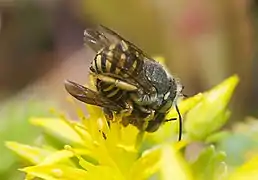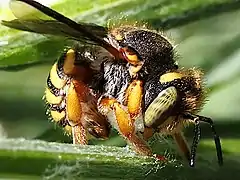| Anthidium oblongatum | |
|---|---|
.jpg.webp) | |
| Scientific classification | |
| Domain: | Eukaryota |
| Kingdom: | Animalia |
| Phylum: | Arthropoda |
| Class: | Insecta |
| Order: | Hymenoptera |
| Family: | Megachilidae |
| Genus: | Anthidium |
| Species: | A. oblongatum |
| Binomial name | |
| Anthidium oblongatum (Illiger, 1806) | |
| Synonyms[1] | |
|
A. oblongatum synonymy
| |
Anthidium oblongatum, the oblong woolcarder bee, is a species of bee in the family Megachilidae, the leaf-cutter, carder, or mason bees.[2][3]
Range
Reported from Morocco in North Africa. In Eurasia from Portugal via southern, central and eastern Europe, Ukraine, southern Russia and Siberia (east to Tuva) as well as via Asia Minor, the Caucasus to the Central Asian mountains and, if the information from Wu (2006) applies, to Inner Mongolia ; in Europe northwards to the Netherlands, Brandenburg, central Poland and Belarus; south to Sicily (not in Corsica and Sardinia), Thessaly (not in Crete and Cyprus), Iran and Afghanistan. Introduced in the eastern United States.[4]
Habitat
Warm and dry locations such as flowering grasslands, hedges, dry stone walls, ruderal sites, weathering heaps, road embankments, railway embankments, flood dams, also in the settlement area (flowering fallow areas, rock gardens). The nesting sites are often spatially separated from the pollen sources and nesting props. From the lowlands to the montane elevation.[4]
Ecology
The flight period is in one generation from mid-June to early August.[4]
A. oblongatum uses cavities to create the nest. Wherever 5–6 mm wide, horizontal crevices are available (dry stone walls, slatey, weathered rocks), these are preferred to be populated. But other cavities also serve as nesting places, for example passage-like cavities in the house, which are also used by Anthidium manicatum. The brood cells are made from vegetable wool.[4] The species populates gardens, especially those that also have suitable food plants and sources of building material. A. oblongatum dabs the outside of the nest with rust-colored glandular secretions. A. oblongatum is found almost exclusively on Fabaceae, especially on Lotus spec. or Onobrychis spec., on Crassulaceae, especially Sempervivum spec. and Sedum spec. or on Resedaceae collecting pollen.[5] Lotus corniculatus, Onobrychis viciifolia and Sedum reflexum are preferred.[4]
Parasites: In France, Stelis punctulatissima was raised from a nest of A. oblongatum. Another breeding parasite, according to observations from Germany and Switzerland, is very likely to be Chrysis marginata.[4]
Etymology
From Latin "oblongatum" = "elongated, elongated"; Illiger does not provide any information on choosing the name.[4]
Taxonomy
Subgenus Proanthidium Friese, 1898[4]
 Copula
Copula Carding wool
Carding wool
References
- ↑ "Anthidium oblongatum". Discover Life. Retrieved 2022-08-25.
- ↑ 2004, Apoidea Database, Fauna Europaea
- ↑ Catalogue of Life : 2009 Annual Checklist : Literature references
- 1 2 3 4 5 6 7 8 Erwin., Scheuchl (2016). Taschenlexikon der Wildbienen Mitteleuropas : alle Arten im Porträt. ISBN 978-3-494-01653-5. OCLC 1041414212.
- ↑ Westrich, Paul 1947- (2019). Die Wildbienen Deutschlands. ISBN 978-3-8186-0881-1. OCLC 1190164412.
{{cite book}}: CS1 maint: numeric names: authors list (link)
External links